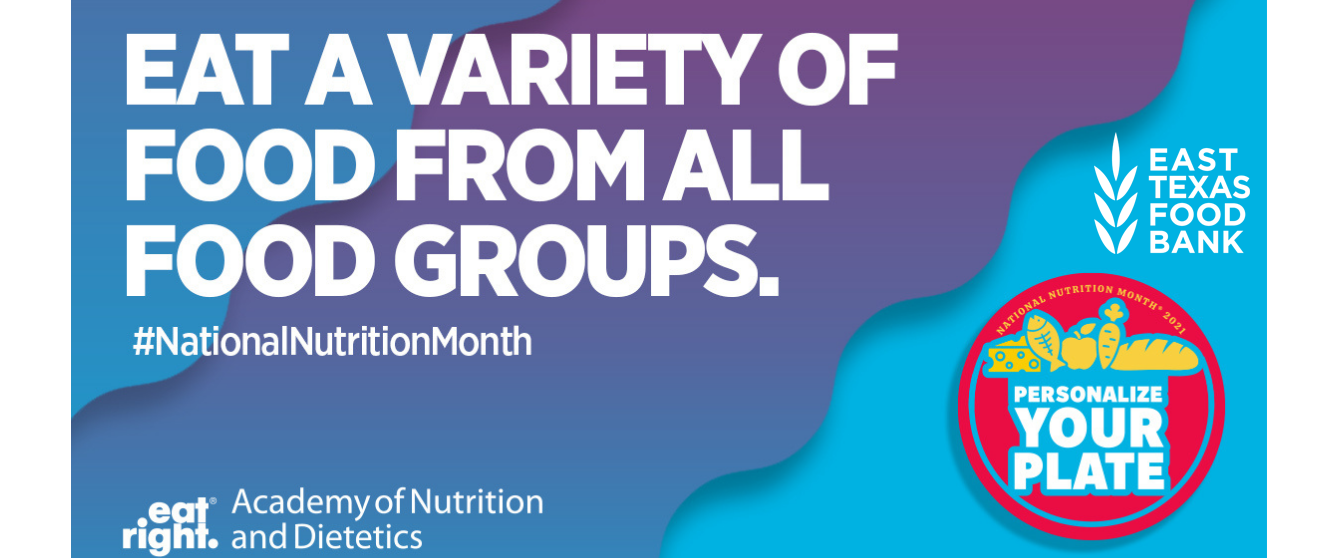National Nutrition Month: Eat a variety of nutrition foods every day!

March is National Nutrition Month®️, and the Academy of Nutrition and Dietetics wants to help give everyone the tools to make informed food choices and develop healthful eating and physical activity habits for life. This year’s theme is to Personalize Your Plate, and this week’s message is to:
Eat a variety of nutritious foods every day!
Follow these tips below to help you know how to eat a balanced diet in a mindful way.
- Include healthful foods from all food groups – eating a balanced diet that includes all food groups is an easy way to help your body get the nutrients it needs.
- Fruits – make half your plate fruits and vegetables! Choose fruit that is fresh, frozen, dried, or canned in 100% fruit juice.
- Vegetables – make half your plate fruits and vegetables! Choose vegetables that are fresh, frozen, or canned without added salt.
- Grains – make half your grains whole grains, like oatmeal, popcorn, quinoa, brown rice, and whole grain flours.
- Protein – try different protein foods, like seafood, beans, peas, lentils, nuts, seeds, soy, eggs, and lean meats and poultry.
- Dairy – choose low-fat or fat-free milk, yogurt, calcium-fortified soymilk, and cheese.
- Hydrate healthfully – staying hydrated helps keep you healthy and helps your body function like it’s supposed to.
- Keep water with you throughout the day, and drink it when you’re thirsty.
- Instead of sugar-sweetened drinks, try drinking water or sparkling water with fruit, vegetables, and/or herbs added. Be creative! Add lemons or limes, strawberries, cucumbers, mint, or basil.
- Fruits, like cantaloupe, strawberries, and watermelon, and vegetables, like lettuce, celery, and spinach, are full of water and can help you stay hydrated.
- Learn how to read Nutrition Facts Panels
- First, look at the servings per container and the serving size. All information on the food label is based on the serving size, so if you eat more than the serving size, you’re getting more of the nutrients listed.
- For one serving of food, try to limit saturated fat, trans fat, sodium, and added sugars to less than 5% of the daily value.
- For one serving of food, try to aim for at least 20% of the daily value for vitamins, minerals, and fiber.
- Check the ingredient list for whole grains and hidden sources of trans fat (partially hydrogenated oils) and sugar (ingredients that end in -ose, honey, and corn sweeteners).
- Avoid distractions while eating – eating while driving, watching TV, or otherwise multitasking prevents you from focusing on what you’re eating and can easily lead to overeating.
- Try turning your phone, computer, and TV off while you eat.
- Try not to snack while you’re working on something else – take a moment to notice why you want to snack. Are you actually hungry or are you feeling bored, stressed, or just wanting something to do with your hands?
- Take time to enjoy your food
- Before you eat, pay attention to how you feel and how your food smells. Are you hungry, stressed, distracted?
- As you eat, pay attention to what your food tastes like and feels like in your mouth.
- After you finish eating, notice how your body feels. Are you still hungry, do you feel overly full, or do you feel satisfied?
Check back next week for more National Nutrition Month information! You can also follow us on Facebook and find healthy recipes here.
